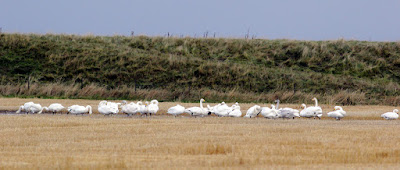We've been Battered by Storm Barney and still the weather doesn't improve. I'm unable to do any ringing or meaningful birding at the moment.
Last week on Another Bird Blog I described how I saw two Robins came to blows in a fearsome territorial dispute and how such clashes can lead to the death of one of the combatants.
Last week on Another Bird Blog I described how I saw two Robins came to blows in a fearsome territorial dispute and how such clashes can lead to the death of one of the combatants.
Robins aren’t the only bird species to exhibit aggression towards their own kind. I was reminded of this today when reading about a recent piece of research by the University of Sheffield which identified the genes that determine the mating behaviour of the male Ruff. The Ruff Philomachus pugnax is another argumentative species, its binomial name referring to the aggressive behaviour of the bird at its mating arenas. Philomachus is derived from Ancient Greek philo - "loving" and machē "battle" and pugnax from the Latin term for "combative”.
Many years ago I used to make regular springtime visits to Warton Marsh on the River Ribble to watch Ruffs on an open grassy area of the marsh. It was fascinating to watch the males in elaborate displays that included wing fluttering, jumping up and down, standing upright or crouching with their ruff erect. The birds often lunged towards or stabbed at rivals with genuine aggression. It was all somewhat comical to watch but deadly serious to the participants.
The Ruff were indulging in a 'lek', a mating system where males of the species gather together and invest all of their energy into attracting females to mate with them. The Ruff is one of the few lekking species in which the display is primarily directed at other males rather than to the females, and it is among the small percentage of birds in which males have well-marked and inherited variations in plumage and mating behaviour.
Alas, Ruff no longer use this local site, the marsh and the immediate area has changed due to the usual “development” and disturbance. Nowadays my sightings of Ruff are restricted to migration time or occasional wintering birds.
Recently, and by using genome sequencing, researchers from the University of Sheffield have identified the genes that determine the striking and often agressive mating behaviour of the male Ruff.
Within this specific mating system three distinct breeding behaviour are identifiable.
• Territorial breeding males have spectacular plumes around their neck (which is why these birds are called Ruffs) and head, and vary enormously in colouration so that each male is distinguishable.
• Non-territorial so-called 'satellite' males, which are distinguishable by their white feathers, concentrate on stealing mates from the territorial displaying males.
• A third type of male, which is thought of as a 'cross-dresser', mimics females. They are able to hide from other males in the lek, so avoiding territorial aggression, and succeed by effectively stealing mates from the resident males.
The new study, by an international team including researchers from the University of Sheffield, Simon Fraser University (Canada), and the University of Edinburgh, published in Nature Genetics, shows that the three distinct breeding behaviour types are encoded by a 'supergene' . This supergene was created several million years ago by a chromosomal rearrangement, which originally allowed the female mimic to evolve and coexist with the territorial males.
Lead author of the study, Professor Terry Burke from the University's Department of Animal and Plant Sciences, said: "The special feature of the supergene is that it allows lots of genes that are next to each other on a chromosome - which in this case determine multiple traits including hormones, feathering, colour and size - to evolve together and create two distinct behavioural traits.
"This process is similar to the one that led to the evolution of separate sex chromosomes, and indeed the alternative forms of the supergene combined together to create the third type of bird personality -- the girlfriend stealer.
"The Ruffs provide a neat example of how small genetic changes can lead to major differences in attractiveness and behaviour. This process is fundamental to the formation of separate sexes and separate species."
He added: "Unlike young men at a social occasion who have each chosen a different approach to courtship, whether that's showing off or paying a compliment, for these birds there is no choice in the matter. It's their DNA that dictates how they win a partner."
Story/Source - Journal Reference:
Clemens Küpper, Michael Stocks, Judith E Risse, Natalie dos Remedios, Lindsay L Farrell, Susan B McRae, Tawna C Morgan, Natalia Karlionova, Pavel Pinchuk, Yvonne I Verkuil, Alexander S Kitaysky, John C Wingfield, Theunis Piersma, Kai Zeng, Jon Slate, Mark Blaxter, David B Lank, Terry Burke. A supergene determines highly divergent male reproductive morphs in the ruff. Nature Genetics, 2015; DOI: 10.1038/ng.3443

































































.jpg)













